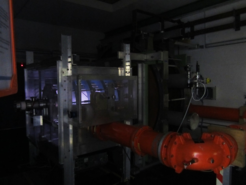IShTAR (Ion Sheath Test Arrangement)
The IShTAR facility was developed to provide data on the ICRF sheaths.
ICRF sheath are a very active research topic with several theoretical path being pursued to understand and be able to calculate and predict the sheaths. The test arrangement intends to provide experimental data for the qualification and benchmarking of the theories. In IShTAR simple (i.e. easy to theoretically model) ICRF mockup antennas can be investigated in realistic plasma edge conditions (density, magnetic field and temperature).

Configuration
The facility is made of a main vacuum vessel equipped with two main coils which can sustain a field of 0.1 T in the center. An ICRF antenna with a maximal length of ... can be installed and powered by an ASDEX Upgrade ICRF generator up to several hundreds of kW. A plasma source is connected on the side of the main vacuum vessel. It is a 1 m long glass tube (radius 40 cm) fed in either Argon or Deuterium and equipped with a RF antenna and magnetic coils. The purpose is to generate in the main vessel, in front of the ICRF antenna, a plasma with the characteristics of a tokamak edge plasma. One way to reach this objective is to use a helicon antenna.
Indeed, in a cylindrical plasma in a static longitudinal magnetic field, the solutions of the wave equations are bounded whistlers. They have the following interesting properties for the need of the testbed:
- they provide better density levels than inductive and capacitive discharge
- they lead to a more uniform ionization
- they are applicable to large volumes of plasma
While a plasma has been obtained in the vessel, which is already relevant for initial sheath tests, two issues will have to be faced if progress to the helicon mode is wanted for achieving higher densities:
- a high level of power is required to reach densities of 1018 m-3 with hydrogen plasma. Though enough power is available, risks of arcing, sputtering and glass tube implosion is to be expected.
- the exact mechanism of power coupling in a helicon source is not yet understood. Part of the studies carried out on IShTAR thus need to be related to the analysis of helicon sources.
